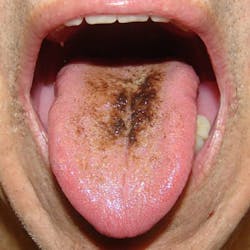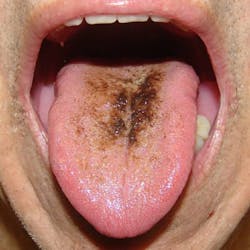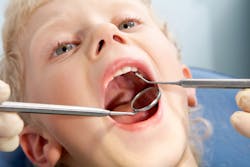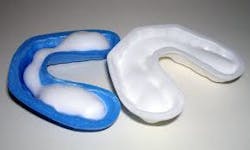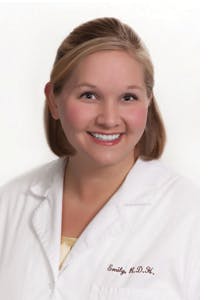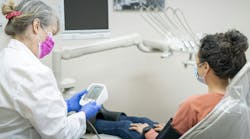Ask Emily: BHT, fluoride options, and parents at pediatric appointments
By Emily Boge, RDH, BS
October 21, 2013
Dear Emily,
I remember learning about black hairy tongue in school, but had never seen a real case until recently. I have to admit that I was pretty grossed out by it, and wanted to help my patient but did not really know how to start the conversation. How do you educate patients on this condition?
Samantha
States with the best (and worst) adult oral health care
Dear Samantha,
As you may remember from your oral pathology background, black hairy tongue (BHT or lingua villosa nigra) is a fairly common benign elongation and discoloration of the papilla on the tongue. Cigarette smoking and poor homecare are the main culprits behind black hairy tongue, but other causes include excessive coffee or soda drinking, dry mouth, antibiotic/bismuth medication use, radiation treatment, or consuming a diet that lacks the roughage necessary to exfoliate the papilla naturally.
The best way to educate the patient with BHT is to set them up and take out a hand mirror and a tongue scraper. I explain to the patient the condition I see and how to gently remove the stain and bacteria from around the elongated papilla. When I show patients the tongue cleaner, many are amazed by how much “gunk” comes off in the initial use. I explain the best time to cleanse the tongue is at night, and they may want to use an antimicrobial rinse following cleansing of the tongue to swish away dead and exfoliated papilla, stains, and germs. My favorite tongue cleanser is the Oolitt brand, but several manufacturers supply tongue cleaners. Some toothbrushes are even equipped with tongue cleaners on the back of the brush head.
Educating patients on tongue cleaning is just as important as educating them on the care of their teeth and gums. Thousands of little “doorknobby projections” live on the tongue, and I tell my patients they need to be cleaned on a daily basis, just like everything else in the mouth.
Dear Emily,
Are parents allowed to come into the exam room with children where you work? I have a some moms that want to come back with their kids, and others that drop their kids off and do not even come into the door of the office. How do you handle this? Any help would be appreciated.
Susan
Dear Susan,
We encourage parents to attend all appointments with their children. Assuring complete medical updates and clear treatment decisions is difficult if you do not have a parent present for a child. In addition, parents are invited back to the operatory with the child if they want to come. Oftentimes, parents choose to wait in the reception area for older children, but it is great to have them present in the event that return treatment needs to be explained or financial arrangements need to be made. Early on in my career it happened on more than one occasion that the doctor prescribed an X-ray or a fluoride treatment and the minor patient stated it would be fine, but later a parent was upset that I completed the service without their permission. Having a parent present removes the chances of getting into a sticky situation after the charges have been made for the day.
Tips to help young hygienists overcome age bias with patients
Dear Emily,
Because I cannot find a full-time job at one office, I work part-time in two separate offices. One does foam fluoride, and will not allow me to do fluoride varnish because they think parents will be unhappy. The other office only completes fluoride varnish because the doctor insists it is the most effective for the patient. What is your opinion on fluoride administration?
Donna
Dear Donna,
A few years back (2006) the American Dental Association Council on Scientific Affairs released a white paper that came from a panel of professionals selected to determine the effectiveness of professionally applied topical fluoride. This panel reported that fluoride gel that maintained contact with isolated teeth for four minutes or more was effective in the reduction of dental caries in school-aged children, but no clinical data that supports one-minute fluoride gel as effective. This same panel also reported that fluoride varnish was effective in the reduction of caries in those at a high risk for caries when placed at least twice a year.
I adore fluoride varnish. The more research I read about it, the better it gets. In addition, it is super easy to apply and virtually invisible thanks to recent improvements.
Let’s say you have Susie, the cutest little five-year-old you ever saw in your chair. She has sat patiently through her health history update with mom, her digital bitewing X-rays, her child prophy, her perio and oral cancer screenings, oral education, an exam by Dr. Amazing, and now it is time for fluoride. Do you want to fight with cotton rolls to isolate her teeth and sit with her and the suction through a four-minute fluoride gel treatment, or would you rather paint on her varnish and have her spit the excess into a cup, get her a sticker, and send her on her way?
To me, especially as a parent, it is a simple choice. Varnish stays on longer and provides an increased benefit without worrying about my child rinsing it out immediately. I want what is best for my patients, and for my own children, so in our office we use only varnish for professional fluoride applications.
---
Resident hygiene expert Emily Boge answers your toughest questions on professional relationships with instructors, employers, and patients, what to use and know in the clinical setting, and how to successfully make the transition from student to professional. Send your questions to [email protected], and you may see it in next month’s column!
More "Ask Emily" columns:
Ask Emily: Why patients forgo X-rays, why you should stir the pot on infection control, and how dental hygiene school is a lot harder than it looks
Ask Emily: Treating kids, using napkin chains, and paying for your own uniform
Ask Emily: Assisting while employed as a hygienist, liability insurance, working interviews
Emily Boge, RDH, BS has practiced as a clinical dental hygienist in Iowa since 2003. She is currently pursuing her master's degree at Upper Iowa University in Health Sciences Public Administration and plans to graduate next year. She has been an active member of her professional associations, ADHA, IDHA, and AADH, and has done research on whitening, desensitization, and the psychological ramifications of missing teeth. She has also served two terms on the Colgate Oral Health Advisory Board. She can be contacted at [email protected] or www.manchestersmiles.com.
